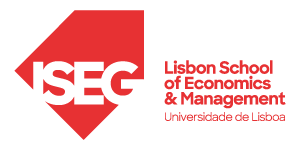Working Papers
For submission of articles or Working Papers to CEsA, please send an email to:
comunicacao@cesa.iseg.ulisboa.pt
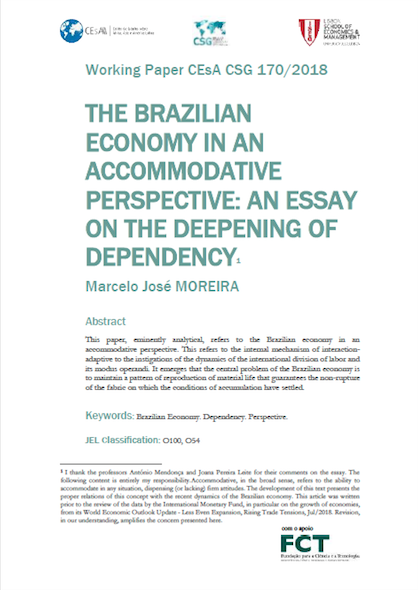
Working Paper 170/2018: The Brazilian Economy in an Accommodative Perspective: An essay on the deepening of dependency
Abstract:
This article, eminently analytical, refers to the brazilian economy in an accommodative perspective. This refers to the internal mechanism of interactionadaptive to the instigations of the dynamics of the international division of labor and its modus operandi. It emerges that the central problem of the Brazilian economy is to maintain a pattern of reproduction of material life that guarantees the non-rupture of the fabric on which the conditions of accumulation have settled. This document aims to propose a way of analyzing the Brazilian economy and its relationship with the recent dynamic of the global economy. In order to do so, one takes into account its dependence trajectory with this dynamics and proposes to analyze it in a perspective of non-structural alteration of the components that support it and, as a hypothesis, of the way these components interact. The components, for the purposes of this essay, are: exports and imports of goods (here called the Decisive Activity), reproduction of the labor force (here considered, as a proxy, for the joint analysis of the unemployment rate and average real income in minimum wages) and the investment rate (as a percentage of GDP).
Quotation:
Moreira, Marcelo José (2018). “The Brazilian Economy in an Accommodative Perspective: An essay on the deepening of dependency”. Instituto Superior de Economia e Gestão – CEsA /CSG – Documentos de Trabalho nº 170/2018.
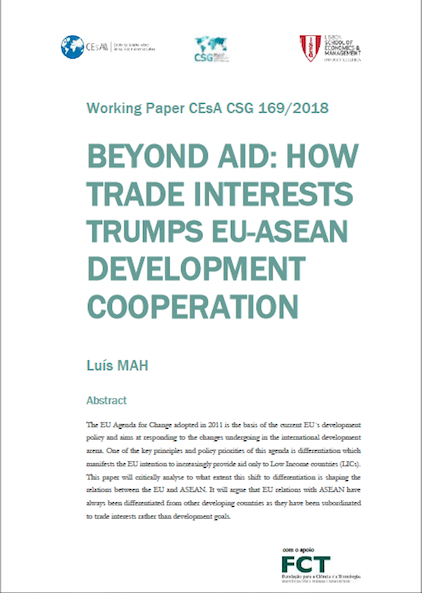
Working Paper 169/2018: Beyond Aid: How trade interests Trumps EU-ASEAN development cooperation
Abstract:
The emergence of new state donors from Latin America, Middle East and Asia as key development partners offering alternative models of development cooperation has had a significant impact on the workings of the international development cooperation arena (Hackenesch & Janus, 2013). The main distinction between the traditional and emerging donors has been the fact that, unlike the former, the latter present themselves as interested parties in what is described to be a mutually beneficial relationship with their development partner countries. In general, these emerging donors have been less eager to respect the dominant OECD-DAC normative discourse on quantity and quality of aid to focus more on mutual economic gains from the relationship. In exchange for aid from these emerging donors, beneficiary countries have been less constrained by political conditionalities and less subjected to scrutiny or oversight on macroeconomic policies. The EU Agenda for Change adopted in 2011 is the basis of the current EU´s development policy and aims at responding to the changes undergoing in the international development arena. One of the key principles and policy priorities of this agenda is differentiation which manifests the EU intention to increasingly provide aid only to Low Income countries (LICs). Beyond Aid: How trade interests Trumps EU-ASEAN development cooperation will critically analyse to what extent this shift to differentiation is shaping the relations between the EU and ASEAN. It will argue that EU relations with ASEAN have always been differentiated from other developing countries as they have been subordinated to trade interests rather than development goals.
Quotation:
Mah, Luís (2018). “Beyond Aid: How trade interests Trumps EU-ASEAN development cooperation”. Instituto Superior de Economia e Gestão – CEsA/ CSG – Documentos de Trabalho nº 169/2018.
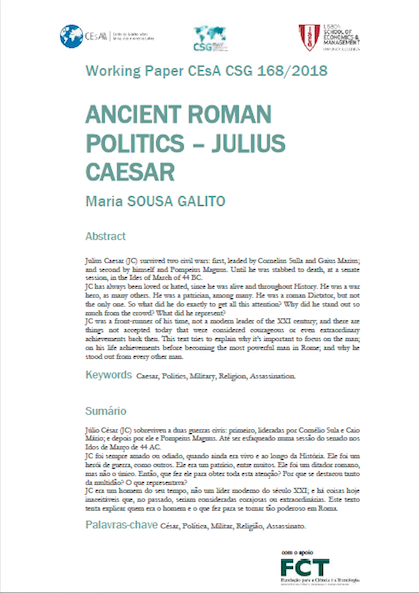
Working Paper 168/2018: Ancient Roman Politics – Julius Caesar
Abstract:
Ancient Roman Politics – Julius Caesar revisits Julius Caesar, one of the most famous conquerors of all time. Many books have been written about him, but not in a neutral way. The texts are usually attached to a political ideology. But reducing his persona to dictatorship can blind people to what he represented to his fellow Romans and who he really was as a man. Julius Caesar survived two civil wars: first led by Cornelius Sula and Gaius Mario; and then by him and Pompey Magnus. Until he was stabbed in a senate session in the Ides of March 44 BC. Julius Caesar was always loved or hated, when he was still alive and throughout history. He was a war hero, like others. He was a patrician, among many. He was a Roman dictator, but not the only one. So what did he do to get all this attention? Why did he stand out so much from the crowd? What did he represent? Julius Caesar was a man of his time, not a modern leader of the 21st century; and there are things unacceptable today that in the past would have been considered courageous or extraordinary. This text tries to explain who the man was and what he did to become so powerful in Rome.
Quotation:
Galito, Maria Sousa (2018). “Ancient Roman Politics – Julius Caesar”. Instituto Superior de Economia e Gestão – CEsA/CSG – Documentos de Trabalho nº 168/2018

Working Paper 167/2018: Ancient Roman Politics the Vestals – Women’s empowerment
Resumo:
Ancient Roman Politics the Vestals – Women’s empowerment is about vestal virgins of ancient Rome. First chapter concerns goddess Vesta, her legends and what she represented. Second chapter is about who Vesta and why her priestesses were important to roman religion. Third chapter explains where they lived. Four chapter lists names of known vestals until Emperor Tiberius (a larger list is included in Appendix 2) and discusses situations involving their deaths or role model. Vestals had political and religious power in ancient Rome. Their peaceful presence at the forum was one of the first attempts (if not the first) in favor of gender equality or women’s empowerment in the public sphere. Vestals were virgin priestesses of a goddess that protected the walls of Rome with her perpetual fire, which was pure and had no statue. Their rituals were based on legends such as Amata or Rhea Silvia that, regardless of being true or not, were religious and cultural references for people’s lives and should not be neglected, because they contain information that explains why the State respected the vestals and punished them so severely.
Citação:
Galito, Maria Sousa (2018). “Ancient roman politics the vestals – women’s empowerment”. Instituto Superior de Economia e Gestão – CEsA/ CSG Documentos de Trabalho nº 167/2018.

Working Paper 166/2018: Portugal and the Euro
Abstract:
Portugal and the Euro is divided in two parts. In the first part, we present some data of the Portuguese economy aiming to capture some of its main long trends and the way it reacts to the introduction of the single currency in Europe. Since Portugal follow a similar path with Spain in what concerns the European economic integration process, we developed a comparative analysis between the two Iberian countries trying to capture some dynamics that can aid to understand the different ways how the two economies reacted to the introduction of the euro and, in this phase of the economic integration in Europe, how they suffered the 2007-2008 international crisis and reacted to its effects. To evaluate and compare the two countries paths we use some fundamental macroeconomic indicators as, output and employment, investment, external accounts, budget balances and government debts. The comparison with Europe’s average economic performance is also present, trying to understand which country follow a more “European path”. In the second part, we concentrate on the euro system crisis trying to give some contributes to the ongoing discussion about the role and effectiveness of the euro as an internal adjustment variable. Not only in terms of the pre-creation of the better conditions for the European economy to respond to cyclical and structural crisis processes, but also in terms of dealing with the developments of the real crisis process that explode in Europe in 2007-2008 and gave origin to what was called the “sovereign debt crisis” that deeply harmed the most week economies, like Portugal but also like Spain. In particular, we discuss the issue of the effectiveness versus the exhaustion of monetary policy followed by the ECB in response to the Eurozone effects of the global economic and financial crisis.
Quotation:
Mendonça, António (2018). “Portugal and the Euro”. Instituto Superior de Economia e Gestão – CEsA/ CSG – Documentos de Trabalho nº 166/2018.
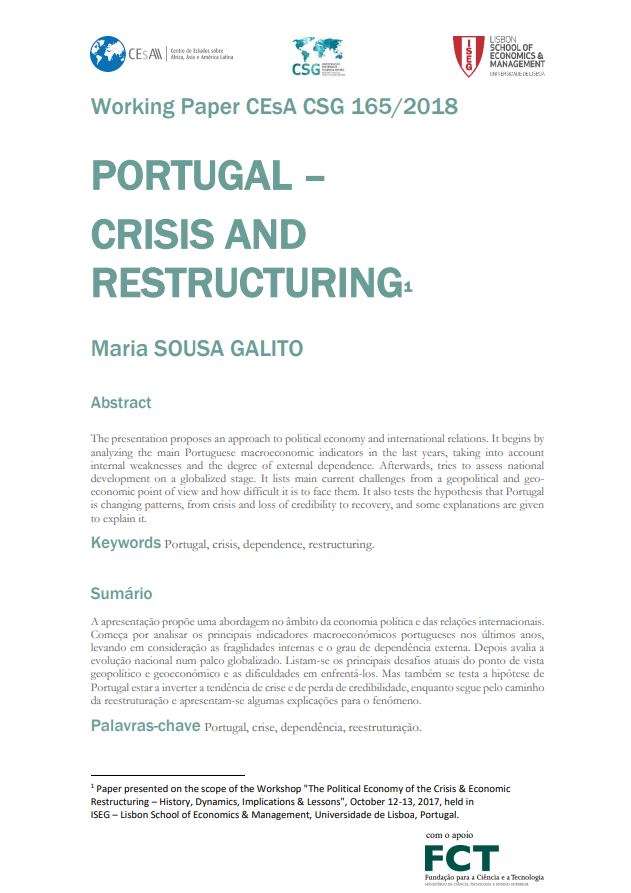
Working Paper 165/2018: Portugal: crisis and restructuring
Abstract:
Portugal is a southwestern country with a strategic triangle including two archipelagos and a territorial slice of the Iberian Peninsula. It’s a State-member of the European Union (EU) since 1986. After 2008 faced financial and economic restrain and asked for financial external help from Troika (IMF, European Commission and European Central Bank) between 2011/14. Taking that in mind, Portugal: crisis and restructuring contextualizes Portugal’s present situation and its trends for the last ten or less years. The first chapter analysis main macroeconomic indicators of Portugal, including the GDP, imports and exports specific performance, consumer price index, net lending/ borrowing by institutional sector, and sovereign ratings from the biggest international agencies. The second chapter evaluates some of the country’s inner fragilities, such as lack of industrialization and unbalanced GVA and Employment between major sectors (agriculture, services and industry), Risk of Poverty, Unemployment Rates and major demographic trends. The third chapter focus on external dependence; studies indicators in percentage of the GDP, like the Liquid External Debt, Emigrants’ Remittances, Public Transferences from and for the EU, but also the Geographical Distribution of Exports and Imports of Goods by Regions and by countries, and of Foreign Direct Investment (FDI) by Countries. The fourth chapter examines the overseas AICEP network, the Global Peace Index, The Travel & Tourism Competitiveness Index and Portuguese indicators like the revenue and number of bed nights by country of origin. A final chapter has a summarized critical assessment about the hypothesis of the EU becoming a federation and Portugal’s part in it. The presentation proposes an approach to political economy and international relations. It begins by analyzing the main Portuguese macroeconomic indicators in the last years, taking into account internal weaknesses and the degree of external dependence. Afterwards, tries to assess national development on a globalized stage. It lists main current challenges from a geopolitical and geo-economic point of view and how difficult it is to face them. It also tests the hypothesis that Portugal is changing patterns, from crisis and loss of credibility to recovery, and some explanations are given to explain it.
Quotation:
Galito, Maria Sousa (2018). “Portugal: crisis and restructuring”. Instituto Superior de Economia e Gestão – CEsA/ CSG – Documentos de Trabalho nº 165/2018.
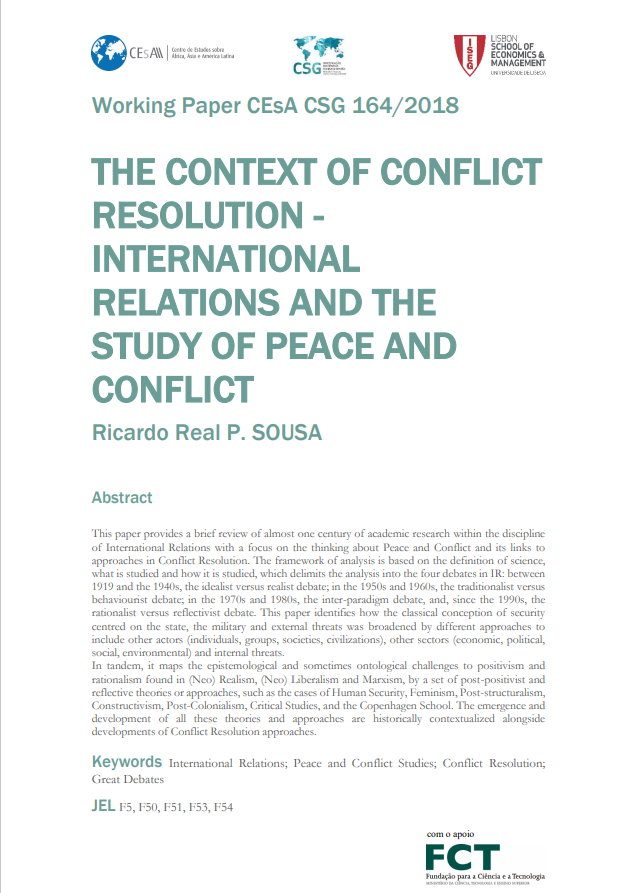
Working Paper 164/2018: The Context of Conflict Resolution: International relations and the study of peace and conflict
Abstract:
The Context of Conflict Resolution: International relations and the study of peace and conflict provides a brief review of almost one century of academic research within the discipline of International Relations with a focus on the thinking about Peace and Conflict and its links to approaches in Conflict Resolution. The framework of analysis is based on the definition of science, what is studied and how it is studied, which delimits the analysis into the four debates in IR: between 1919 and the 1940s, the idealist versus realist debate; in the 1950s and 1960s, the traditionalist versus behaviourist debate; in the 1970s and 1980s, the inter-paradigm debate, and, since the 1990s, the rationalist versus reflectivist debate. This paper identifies how the classical conception of security centred on the state, the military and external threats was broadened by different approaches to include other actors (individuals, groups, societies, civilizations), other sectors (economic, political, social, environmental) and internal threats. In tandem, it maps the epistemological and sometimes ontological challenges to positivism and rationalism found in (Neo) Realism, (Neo) Liberalism and Marxism, by a set of post-positivist and reflective theories or approaches, such as the cases of Human Security, Feminism, Post-structuralism, Constructivism, Post-Colonialism, Critical Studies, and the Copenhagen School. The emergence and development of all these theories and approaches are historically contextualized alongside developments of Conflict Resolution approaches.
Quotation:
Sousa, Ricardo Real P. (2018). “The Context of Conflict Resolution: International relations and the study of peace and conflict”. Instituto Superior de Economia e Gestão – CEsA/ CSG Documentos de Trabalho nº 164/2018.
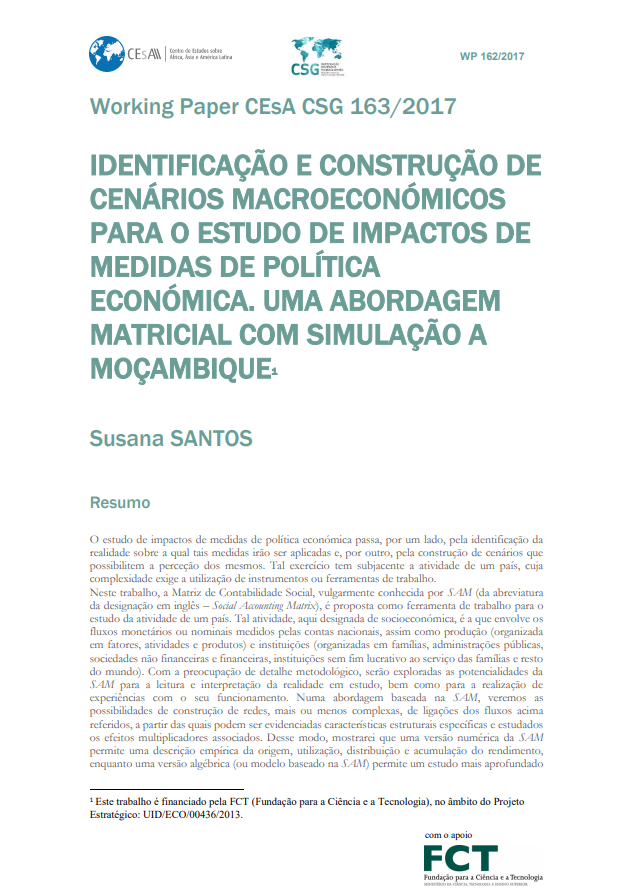
Working Paper 163/2017: Identificação e Construção de Cenários Macroeconómicos para o Estudo de Impactos de Medidas de Política Económica. Uma abordagem matricial com simulação a Moçambique
Abstract:
The study of the impacts of economic policy measures involves, on the one hand, the identification of the reality on which such measures will be applied and, on the other hand, the construction of scenarios that allow their perception. This exercise is based on the activity of a country, whose complexity requires the use of instruments or work tools. Identificação e Construção de Cenários Macroeconómicos para o Estudo de Impactos de Medidas de Política Económica. Uma abordagem matricial com simulação a Moçambique, the Social Accounting Matrix, commonly known as SAM (from the abbreviation of the name in English – Social Accounting Matrix), is proposed as a working tool for the study of the activity of a country. Such activity, here designated as socio-economic, involves monetary or nominal flows measured by national accounts, as well as production (organized into factors, activities and products) and institutions (organized into households, public administrations, non-financial and financial corporations, non-profit institutions serving families and the rest of the world). With a concern for methodological detail, the potential of SAM will be explored for the reading and interpretation of the reality under study, as well as for carrying out experiments with its operation. In an approach based on SAM, we will see the possibilities of building networks, more or less complex, of connections of the flows mentioned above, from which specific structural characteristics can be highlighted and the associated multiplier effects studied. In this way, I will show that a numerical version of the SAM allows an empirical description of the origin, use, distribution and accumulation of income, while an algebraic version (or model based on the SAM) allows for a more in-depth study of the multiplier effects (or impacts) associated with changes in these flows, caused by the adoption of policy measures, for example. I will exemplify such potentialities of SAM, giving special attention to the functional and institutional distribution of income, through the construction and analysis of two scenarios involving changes in the remuneration of production factors and in the income of institutions. Such an application will allow the identification of the relevant role of production factor accounts (from SAM), as they establish the link between income generation and the corresponding distribution and use. I will also emphasize the importance of a matrix approach in the identification and construction of macroeconomic scenarios in the study of impacts of economic policy measures, highlighting the complementary details that an InputOutput Matrix (IOM) can add. An application to the case of Mozambique in 2015 will accompany the presentation. In this application we will often talk about simulation due to the unavailability of information regarding all the flows worked.
Quotation:
Santos, Susana (2017). “Identificação e construção de cenários macroeconómicos para o estudo de impactos de medidas de política económica. Uma abordagem matricial com simulação a Moçambique”. Instituto Superior de Economia e Gestão – CEsA/ CSG – Documentos de Trabalho nº 163/2017.
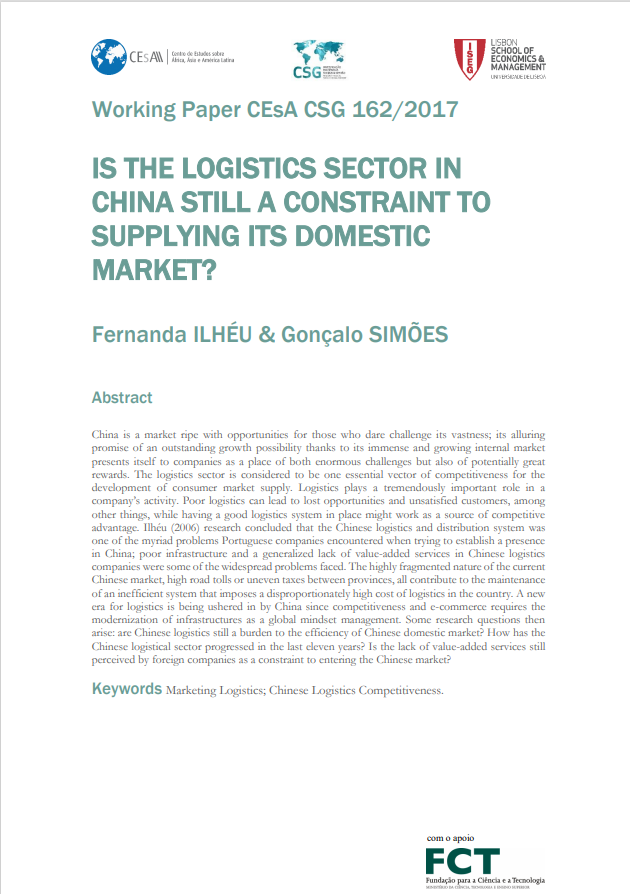
Working Paper 162/2017: Is the Logistics Sector in China Still a Constraint to Supplying its Domestic Market?
Abstract:
China is a market ripe with opportunities for those who dare challenge its vastness; its alluring promise of an outstanding growth possibility thanks to its immense and growing internal market presents itself to companies as a place of both enormous challenges but also of potentially great rewards. The logistics sector is considered to be one essential vector of competitiveness for the development of consumer market supply. Logistics plays a tremendously important role in a company’s activity. Poor logistics can lead to lost opportunities and unsatisfied customers, among other things, while having a good logistics system in place might work as a source of competitive advantage. In Is the Logistics Sector in China Still a Constraint to Supplying its Domestic Market? we continue the Ilhéu (2006) research that concluded that the Chinese logistics and distribution system was one of the myriad problems Portuguese companies encountered when trying to establish a presence in China; poor infrastructure and a generalized lack of value-added services in Chinese logistics companies were some of the widespread problems faced. The highly fragmented nature of the current Chinese market, high road tolls or uneven taxes between provinces, all contribute to the maintenance of an inefficient system that imposes a disproportionately high cost of logistics in the country. A new era for logistics is being ushered in by China since competitiveness and e-commerce requires the modernization of infrastructures as a global mindset management. Some research questions then arise: are Chinese logistics still a burden to the efficiency of Chinese domestic market? How has the Chinese logistical sector progressed in the last eleven years? Is the lack of value-added services still perceived by foreign companies as a constraint to entering the Chinese market?
Quotation:
Ilhéu, Fernanda e Gonçalo Simões (2017). “Is the Logistics Sector in China Still a Constraint to Supplying its Domestic Market?”. Instituto Superior de Economia e Gestão – CEsA/ CSG – Documentos de Trabalho nº 162/2017

Working Paper 161/2017: Foreman of the Empire? Re-analysis of the readmission agreement with the European Union and the repatriation in the archipelago of Cape Verde
Abstract:
This article firstly presents an overview of legal framework and the weaknesses in the management of immigration in Cape Verde, analyzing in a particular way the Cape Verde readmission agreement with the European Union within the established special partnership (specifically the mobility partnership) with this same organization. On the other hand, it analyzes the Migration containment policies and management of the repatriated/deported in the archipelago, focusing on its close relationship with the phenomenon of readmission. This scenario leads to the question of whether Cape Verde is to transform or not into a “foreman of the empire”, that is, a praetorian guard in one of the most advanced frontiers of Europe. Trying to understand the complexity of migration to Cape Verde Island, one should also highlight the historical importance of links on the mobility of people, which played a key role in disseminating information and contacts between the pre-colonial societies. It should also refer to the implications of European colonial process in migration dynamics in the African continent, with the delineation of borders, through the recruitment of work force, or by using strategies for planning political and administrative control of the populations.
Quotation:
Varela, Odair Barros e Redy Wilson Lima (2017). “Foreman of the Empire? Re-analysis of the readmission agreement with the European Union and the repatriation in the archipelago of Cape Verde”. Instituto Superior de Economia e Gestão – CEsA/CSG – Documentos de Trabalho nº 161/2017.


